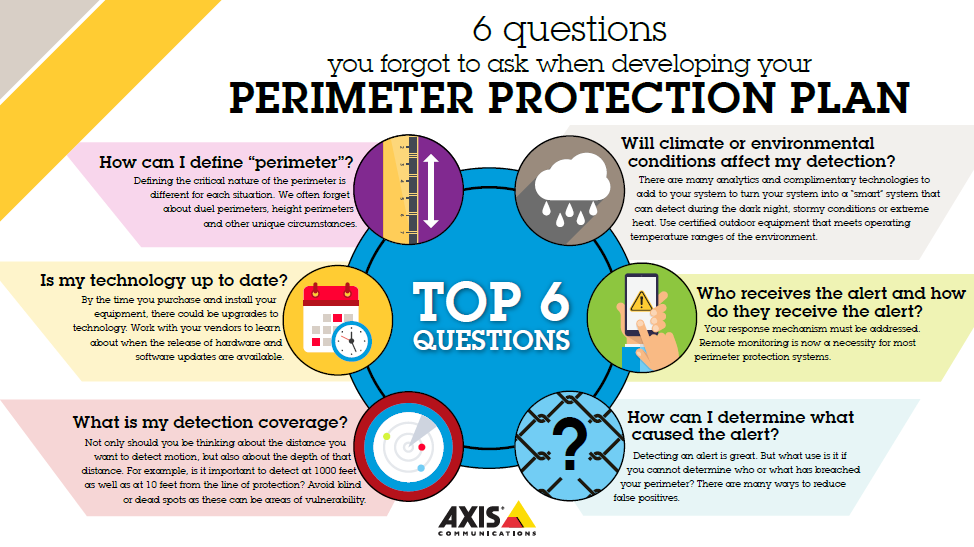6 questions you may have forgotten to ask when developing your perimeter protection plan
It takes more to protect a perimeter than simply building a tall fence topped with barbed wire. A well-secured perimeter contains myriad layers of defenses reinforced with robust security solutions.
More than ever before, organizations are realizing the value of stopping criminals well before they can damage property, or hurt customers or employees. In fact, the global perimeter security market is set to reach $439,642 million by 2028 according to a 2021 report by Research and Markets, a leading market research store.
Yet, despite this, there still exists one fundamental problem: Some are still struggling to develop and implement a comprehensive perimeter protection plan. To help with this process, here are six questions you may have forgotten to ask when designing your perimeter protection blueprint:
1. How can I define “perimeter?”
Perimeters are any borders that mark off or protect one area from another, and perimeter protection consists of safeguarding vulnerable locations or structures within those perimeters.
When developing a perimeter protection plan, one of the first things you should consider is the perimeter’s size. Usually, more fencing and security solutions are needed to secure longer perimeters.
Take, for example, Denver International Airport. In December 2021, passengers were delayed in reaching the airport’s terminals when trains shut down in response to a security breach. A man had bypassed security checkpoints while making it down the escalators to the train platform from the arrivals area. In 2015, AP reported that over the last decade, eight people had breached the 53-square-mile property that contains roughly 30 miles of physical perimeter fencing.. Other large airports have fences that run similar lengths or longer.
Now, imagine trying to develop and implement a plan that places an equal amount of attention to every square inch of a miles-long perimeter? It’s not easy to do, but to help, we suggest considering at least the following:
- Identify all entrance and exit points: Typically, intruders penetrate these areas first because they’re often the easiest to breach.
- Examine the physical perimeter: Physical perimeters can contain walls, fences or other environmental structures or barriers, and sometimes natural vegetation.
- Consider the effects of a breach: Do you need to be alerted when an intruder breaches a fence, or is the distance or direction of the intruder’s movement more important for an alert? It’s crucial to think of the critical to non-critical nature of the property as concentric circles with the center being the most critical and moving outwards from there.

2. Is my technology up to date?
It’s important to use the most updated security solutions for a few reasons. Some include:
– Staying in regulatory compliance: Healthcare organizations or enterprises that work for federal agencies are often required by law to keep their security solutions up to date to avoid penalties.
Healthcare facilities, for example, must comply with the Health Insurance Portability and Accountability Act —commonly referred to as HIPAA—and other strict state and federal protocols. In part, these require them to regularly update their security solutions to prevent physical infrastructure and data breaches.
– Improving product efficiency: Technologies in video motion detection have evolved from pixel-based analysis to a smarter, object-based detection that can alert based on object type. IP devices are powerful at the edge and can run advanced analytics for detection and reducing false events.
This is beneficial in a number of ways. Adopting edge analytics can lessen the demands on the central server processing. This new capacity appliance can be utilized by other applications, potentially mitigating additional applications, potentially mitigating additional hardware costs to accomplish the same task. This distributed process of using edge devices for running advanced analytics also allows for a system failure to be isolated. Imagine if a central server running advanced analytics goes down? You lose operability of those analytics on all attached devices. A distributed system isolates that to just the offending devices if a failure were to happen.
– Protecting against cyber attacks: By nature of being connected to networks, Internet of Things (IoT) technology, such as IP cameras and other end points, have potential to be vulnerable to cyber attacks. Distributed Denial-of-Service attacks, commonly known as DDoS attacks, continue to grow in number and size, according to the latest research from Cloudfare. These can cripple security solutions by either crashing systems or, at minimum, blocking access to video footage. Downloading the latest solution updates and patches can help better protect companies from cyber threats.
When thinking about solution updates, ask yourself whether you’ve also explored how other detection methods, such as fence and ground loops, passive infrared, radar, dual sensor, microwave, thermal cameras, public address speakers and lighting, fit into your overall perimeter protection plan. And consider whether the technology is open to integration or works as a whole unit through a common platform.
3. Will climate or environmental conditions affect my detection?
Climate and environmental conditions can affect security equipment and its level of detection. For example, in scenes involving extreme lighting or backlight—such as cameras facing a rising or setting sun or operating at night—analog cameras could have difficulty producing clear images. In this case, IP cameras fitted with wide dynamic range or thermal technology are more appropriate technology to use.
Lighting, however, isn’t the only potential issue security professionals may face. Image stabilization can become a concern when cameras are subject to high winds or even motorized equipment. Electronic image stabilization (EIS) can reduce shaking caused by high and low amplitude vibrations and wind.
For facilities that operate in extreme conditions, operators must take into consideration more than just the functions and features of security solutions. Here are a few other aspects to think about:
– Humidity: If condensation forms inside a camera lens, it can both blur images and erode electronics. Cameras exposed to constant air pressure changes and heavy rainfall can cause seals and other components to crack, allowing moisture to build up inside. The best cameras often factor humidity into their design with internal fans and quick dry technology.
– Environmental conditions: Coastal locations with high salt content in the air can corrode security equipment over time. The same can be said of food, medical and clean room manufacturing facilities where highly aggressive cleaning chemicals are used. If installing equipment in this type of environment, using outdoor-ready cameras with stainless steel or all-polycarbonate housings can prevent corrosion caused by sea water and even cleaning agents.
– Temperature: Operating in arctic conditions? Frigid temperatures freeze, erode and prevent parts from functioning properly. If the camera doesn’t have speed-dry technology or temperature control, ice may form on the lens, resulting in blurry images, or the camera may fail to power up correctly if at all.
– Mounting: Not every surface is the same. For example, cameras mounted on porous walls or ones that allow for extreme temperature transfer (hot to cold) may be exposed to more moisture. By considering mounting prior to installation, you can better protect cameras from harsh environmental conditions and extreme temperature shifts.
4. Who receives the alert and how do they receive it?
To monitor perimeters at all times and in multiple locations, adding a network video-based system including IP audio and video analytics to traditional security measures provides highly reliable intrusion detection. These solutions allow security personnel to survey perimeters whether they’re observing monitors, patrolling facilities or off-premise using mobile devices.
Perimeter protection solutions also evaluate situations and notify personnel only when there’s a true threat. By dismissing non-threatening subjects or events, employees have a better opportunity to verify the nature of the risk and respond appropriately.
This level of security helps businesses threefold:
– Reduces penalties and fees: In 2020, Moose Jaw Police Service responded to 236 false alarm calls and 925 over the previous three years. This prompted discussions to raise the annual alarm line permit fees from $15 to $25 and the suspended permit line (following two false alarms) fees from $75 to $100per use.
False alarms can cost businesses hundreds if not thousands of dollars. The best monitoring solutions reduce false alarms by identifying only true threats.
– Lowers property damage and losses: Responding quickly to a perimeter breach helps prevent the damage or loss of property. However, as we mentioned, the number of false alarms nationwide is staggering. Take, for example Austin, Texas. In a 2020 Austin police report, it was revealed that 95 percent of all burglar alarm calls were false alarms.
In response to incidents like this, some cities have refused outright to respond to alarms at addresses that have a high rate of falsity. Facilities that don’t have the right perimeter protection solutions and protocols in place are at increased risk for breaches and property damage.
– Decrease business disruptions: Perimeter protection solutions can decrease the number of or lessen the effects of business disruptions caused by false alarms. This is especially important in airports where a single perimeter breach can stall takeoffs, potentially costing airports thousands of dollars in lost revenue and fines.
Take, for example, Newark Liberty International airport in September 2022. Authorities had to fully evacuate a terminal after a person waiting in the TSA line entered a security door. After an hour of locating the individual travelers were let back inside. However, as everyone had to be re-screened to get back into the terminal, this created up to three hours of additional queing for some.
Security solutions with remote capabilities can quickly alert airport personnel, ensuring that intruders—such as the one who entered Newark Liberty International Airport—are apprehended before or, at worst, immediately after a breach occurs.
5. How can I determine what caused the alert?
Identifying what caused an alert or who the threat is, is made easier with the right perimeter protection solutions.
For example, thermal cameras with intelligent video analysis not only produce significantly fewer false alarms than optical cameras, they’re also less sensitive to severe environmental conditions, such as rain, snow and fog. Some thermal cameras are also equipped with EIS to keep them stable in windy conditions.
Of course, thermal cameras can only go so far when attempting to physically detect who the threat is. But when they’re coupled with remote monitoring capabilities, thermals can quickly notify personnel so they can verify the threat in person or by using visual cameras.
In environments with poor or extreme lighting, security equipment can have trouble properly identifying intruders. An example may include cameras pointed directly at vehicles with strong headlights. Solutions fitted with wide dynamic range can essentially restructure scenes so that objects can be better viewed in environments that have a wide range of lighting conditions.
Another idea is to use cameras equipped with 940nm infrared light because they illuminate dark scenes. While IR doesn’t produce natural colors, IR cameras with 940nm are great for covert situations because the light is invisible to the human eye.
However, like any solution-type, IR cameras do have some weaknesses:
- They’re less efficient in wet weather because water drops can cause reflections and refractions back to the visual camera, degrading image usability.
- It’s typically more effective when it’s bouncing off multiple objects to flood the environment. In environments with really dark or bright objects, the IR light may not properly reflect.
- Criminals may see a lower wavelength IR because it has a dim, red glow and attempt to destroy the camera or housing.
Finally, simply adding auxiliary lighting to scenes that are too dark can help better identify intruders, although this may increase overall perimeter security costs in the long run.
6. What is my detection level?
A key concern for security personnel should be eliminating blind spots along perimeters. For example, is it just as important to clearly detect a threat at 10 feet as it is at 1,000 feet? If the answer is “yes,” look beyond a solution’s specification sheets and evaluate the whole situation.
All products can fail if they’re not installed and implemented properly. Knowing the real-world practical uses of perimeter protection technology, as well as their detection limitation ranges can help personnel better engineer solutions.
For example, having a thermal camera cover up to 1,000 feet is great for a fence line, but what if the operator needs to know if the intrusion is a human or an animal? These parameters might reduce the model and detection range based on system needs, environmental conditions and the overall terrain.
Want to learn more about our high-security, scalable perimeter protection?




